An alternative approach, using a common base class with virtual methods:
#include <iostream>
struct IntOp {
virtual int get() = 0;
};
struct ConstInt: IntOp {
int n;
explicit ConstInt(int n): n(n) { }
virtual int get() override { return n; }
};
struct MultiplyIntInt: IntOp {
IntOp *pArg1, *pArg2;
MultiplyIntInt(IntOp *pArg1, IntOp *pArg2): pArg1(pArg1), pArg2(pArg2) { }
virtual int get() override { return pArg1->get() * pArg2->get(); }
};
int main()
{
ConstInt i3(3), i4(4);
MultiplyIntInt i3muli4(&i3, &i4);
std::cout << i3.get() << " * " << i4.get() << " = " << i3muli4.get() << '\n';
return 0;
}
Output:
3 * 4 = 12
Live Demo on coliru
As I mentioned std::function in post-answer conversation with OP, I fiddled a bit with this idea and got this:
#include <iostream>
#include <functional>
struct MultiplyIntInt {
std::function<int()> op1, op2;
MultiplyIntInt(std::function<int()> op1, std::function<int()> op2): op1(op1), op2(op2) { }
int get() { return op1() * op2(); }
};
int main()
{
auto const3 = []() -> int { return 3; };
auto const4 = []() -> int { return 4; };
auto rand100 = []() -> int { return rand() % 100; };
MultiplyIntInt i3muli4(const3, const4);
MultiplyIntInt i3muli4mulRnd(
[&]() -> int { return i3muli4.get(); }, rand100);
for (int i = 1; i <= 10; ++i) {
std::cout << i << ".: 3 * 4 * rand() = "
<< i3muli4mulRnd.get() << '\n';
}
return 0;
}
Output:
1.: 3 * 4 * rand() = 996
2.: 3 * 4 * rand() = 1032
3.: 3 * 4 * rand() = 924
4.: 3 * 4 * rand() = 180
5.: 3 * 4 * rand() = 1116
6.: 3 * 4 * rand() = 420
7.: 3 * 4 * rand() = 1032
8.: 3 * 4 * rand() = 1104
9.: 3 * 4 * rand() = 588
10.: 3 * 4 * rand() = 252
Live Demo on coliru
With std::function<>, class methods, free-standing functions, and even lambdas can be used in combination. So, there is no base class anymore needed for nodes. Actually, even nodes are not anymore needed (explicitly) (if a free-standing function or lambda is not counted as "node").
I must admit that graphical dataflow programming was subject of my final work in University (though this is a long time ago). I remembered that I distinguished
- demand-driven execution vs.
- data-driven execution.
Both examples above are demand-driven execution. (The result is requested and "pulls" the arguments.)
So, my last sample is dedicated to show a simplified data-driven execution (in principle):
#include <iostream>
#include <vector>
#include <functional>
struct ConstInt {
int n;
std::vector<std::function<void(int)>> out;
ConstInt(int n): n(n) { eval(); }
void link(std::function<void(int)> in)
{
out.push_back(in); eval();
}
void eval()
{
for (std::function<void(int)> &f : out) f(n);
}
};
struct MultiplyIntInt {
int n1, n2; bool received1, received2;
std::vector<std::function<void(int)>> out;
void set1(int n) { n1 = n; received1 = true; eval(); }
void set2(int n) { n2 = n; received2 = true; eval(); }
void link(std::function<void(int)> in)
{
out.push_back(in); eval();
}
void eval()
{
if (received1 && received2) {
int prod = n1 * n2;
for (std::function<void(int)> &f : out) f(prod);
}
}
};
struct Print {
const char *text;
explicit Print(const char *text): text(text) { }
void set(int n)
{
std::cout << text << n << '\n';
}
};
int main()
{
// setup data flow
Print print("Result: ");
MultiplyIntInt mul;
ConstInt const3(3), const4(4);
// link nodes
const3.link([&mul](int n) { mul.set1(n); });
const4.link([&mul](int n) { mul.set2(n); });
mul.link([&print](int n) { print.set(n); });
// done
return 0;
}
With the dataflow graph image (provided by koman900 – the OP) in mind, the out vectors represent outputs of nodes, where the methods set()/set1()/set2() represent inputs.

Output:
Result: 12
Live Demo on coliru
After connection of graph, the source nodes (const3 and const4) may push new results to their output which may or may not cause following operations to recompute.
For a graphical presentation, the operator classes should provide additionally some kind of infrastructure (e.g. to retrieve a name/type and the available inputs and outputs, and, may be, signals for notification about state changes).
Surely, it is possible to combine both approaches (data-driven and demand-driven execution). (A node in the middle may change its state and requests new input to push new output afterwards.)
